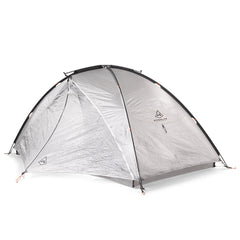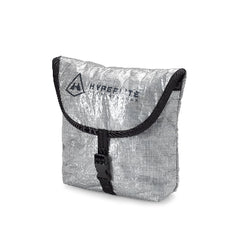Words and Photos from David Jackson
@davidjackson_ @exploreleahjackson
Northern Ontario, that mysterious, remote region of Canada north of Minnesota, has been seriously underfed by winter this season. Typically, the cold would ruin exposed skin, snowshoes of the more traditional, wide bear paw style would be mandatory to move through the snowy boreal wonderland.

For the first time in collective memory, this isn’t the case. Our forests are snowless, inland lakes are well covered in ice, but the trails that connect, the rough, magical portages we roam in the winter, can’t slide a sleigh. We are locked out, shut off, from the places we disappear to for frozen months with a wood stove and canvas tent. We needed to get creative–to stop being bitter about the season, so we went to explore the frozen bays of Lake Superior, which is experiencing a historic low ice coverage of just 1.7%.

With sleighs loaded for only one week, we set out to see what the ice edge looked like, to visit the spot where safe ice meets swells and open water.

It took my wife and I one full day walk to reach the ice edge, or at least as close as we dared set camp to it, a spot 20 miles south of our yard. The black, blue, and white ice was mostly snowless and gave a sense of deep cold, but it wasn’t. The brown, leafless shorelines and huge vista gave a peripheral sense of a tundra landscape, as if we were transported to the wonderful Arctic so close to home. The temperatures ranging from -15F to 32F reminded us instead that we were in a temperamental, confused climate, not the far north.


We ventured to a reef to jig up some dinner and punched holes through ice so clear we figured the fish would be visible swimming underneath, and sure enough, it was. Soon, we had Whitefish and Lake Trout racing underfoot, their tales slapping the ice when we hoisted them top side to satisfy our palette for the winter delicacy we crave of fresh fish.


On shore, we lit a fire, cleaned a larger trout for smoking, and let it broil and char in the blazing heat of a bonfire. Atop a piece of sourdough bread Leah baked before the trip with cheese, the smokey fish melted in our mouths. After all, we go to the land for this, and if we were staving frostbite in the too-warm February sun, we were at least getting sweet tans doing what we love.


The next morning, we noticed wolf prints crossing our tracks; a pack was investigating the fish-eating strangers roaming their hunting grounds.

As we neared our fishing holes from a day earlier, we paused, stopped, and backed off; they were underwater. The ice sheet, which was well beyond the margins of safe walking and attached to a very thick, 35-mile-long ice chunk, had fractured and detached overnight.

As we retreated, I put a leg through another cracked-off portion hidden by a layer of snow, and it really hit home that we were on thin ice this season. By the end of the day, it was entirely open water where we had fished the day before, and we hung closer to camp on ice two feet thick, watching for the wolves we knew were curious about us.

Leah spied one cruising the downwind edge of the open water, and we watched as its black coat disappeared into the distant mirage. In camp that night, after the sky burned pink and we had processed firewood for the tent, an owl woke up to speak in cadence with the booming, chatty lake ice. The groaning and moaning weren’t the sounds we attribute to the creation of ice. Instead, it was the harsh sound of giant sheets of ice under tremendous pressure from its constant shifting and rearranging.

Our walk home satisfied the anxieties of what we knew–the large frozen bay had indeed shifted, and to complicate our return journey, we had to navigate across three giant, new pressure ridges. The ice sheets had pushed each other on top or underneath, and what remained were sometimes six-foot-high walls of ice with open water on either side. When we found bridges across all three, we raced for home in the darkness against a north wind, its fury tempting us to go back, to stay out.

But we heard there’s snow in the forecast, and maybe winter will have the final word this season. If it does, we’ll be there to greet it, roaming the frozen, frosty, and hopefully snowy countryside we love.























